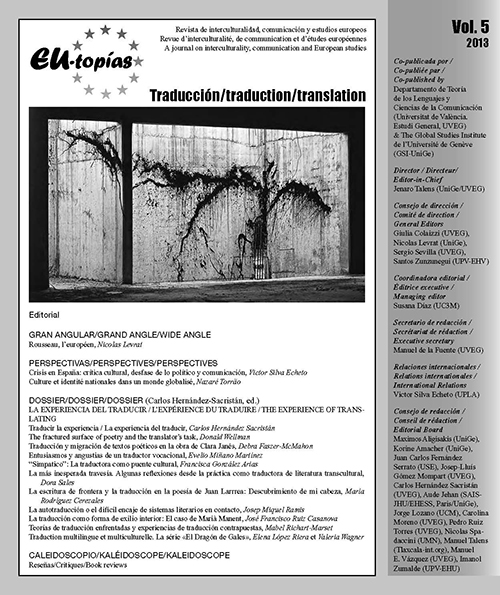The fractured surface of poetry and the translator's task
DOI:
https://doi.org/10.7203/eutopias.0.19784Keywords:
Translation, poetry, close reading, fractured expression Abstract
Abstract
Every translation is partial. At its best a translation captures only elements that inhere in the original. This is especially true of the translation of poetry. Translation fractures the bond between language and content that distinguishes poetry from other uses of language. I apply this lesson to examples drawn from my translations of the works of Antonio Gamoneda and Emilio Prados. My translations may approach some qualities found in the original but fail to rival the integrity of the source texts. I also argue that translation provides a uniquely situated form of close reading and that similar processes of close reading are useful in working with experimental or avant-garde poetry like that of John Ashbery or Charles Bernstein. This dynamic of close reading is doubled again in its force and value when translating innovative texts from a home language to a host language.
 Downloads
Downloads
 References
References
AGAMBEN, Giorgio, Lorenzo CHIESA and Matteo MANDARINI (2011), The Kingdom and the Glory: For a Theological Genealogy of Economy and Government, Palo Alto: Stanford University Press.
ALMOND, Ian (2002), «Different Fragments, Different Vases: a Neoplatonic Commentary on Benjamin’s’ The Task of the Translator», Heythrop Journal, XLIII, pp. 185-198.
ASHBERY, John (2010), El Juramento de la pista de frontón: The tennis court oath, bilingual edition, trans. Julio Mas Alcaraz, Barcelona: Calambur.
BARGLOW, Raymond (1998), «The Angel of History: Walter Benjamin’s Vision of Hope and Despair», Tikkun Magazine, November 1998, http://www.barglow.com/angel_of_history.htm
BENJAMIN, Walter (1968), «The Task of the Translator», in Illuminations, trans. Harry Zohn, New York: Schocken, pp. 69-82
BENJAMIN, Walter (1997), «The Translator’s Task», TTR (Traduction, Terminologie, Rédaction), 10 (2), pp. 151-165, trans. Steven Rendall, http://id.erudit.org/iderudit/037302ar. Also available in Lawrence Venuti, ed. (2012), The Translation Studies Reader, 3rd ed., London: Routledge.
BENJAMIN, Walter (1968), «Theses on the Philosophy of History», in Illuminations, trans. Harry Zohn, New York: Schocken, pp. 253-264.
BERNSTEIN, Charles (libretto) and Brian Ferneyhough (music) (2005), Shadowtime, Los Angeles: Green Integer.
BERNSTEIN, Charles (1992), «Artifice of Absorption», in A Poetics, Cambridge: Harvard University Press, pp. 9-89.
CATULLUS, Gaius Valerius, [Works,] in Catullus, Tibullus, and Pervergilium Veneris, F. W. Cornish, et al., translators, second edition, revised by G.P. Goold, Loeb Classical Library, Cambridge: Harvard University Press and London: Heinemann, [1913] 1988, 62.
EASTMAN, Andrew (2009), «Estranging the Classic: The Zukofskys’ Catullus», Revue LISA/LISA e-journal [Online], Vol. VII – n°2 | 2009, Online since 02 June 2009, connection on 20 August 2012. http://lisa.revues.org/312
GAMONEDA, Antonio (2004), Libro del frío in Esta luz: poesía reunida (1947-2004).Barcelona: Galaxia Gutenberg / Círculo de Lectores.
PRADOS, Emilio (1999), Poesías completas. Madrid: Visor.
SCHOLEM, Gershom (1923), Das Buch Bahir. Volume 1 of Quellen und Forschungen zur Geschichte der jüdischen Mystik. Editor, Robert Eisler. Drugelin.
SMITH, Dan (1997), Introduction to Gilles Deleuze, Essays Critical and Clinical, Minneapolis: University of Minnesota Press, pp. xi-liii.
STEVENS, Wallace (1997), Collected Poetry and Prose, New York: Library of America.
VENUTI, Lawrence (1995), The Translator’s Invisibility. A History of Translation, London: Routledge.
WELLMAN, Donald (2010), A North Atlantic Wall. Loveland: Dos Madres.
ZUKOFSKY, Celia and Louis, translators (1969), Catullus (Gai Valeri Catulli Veronensis Liber). London: Cap Golliard.
ZUKOFSKY, Louis (1987), Bottom on Shakespeare, Berkeley: University of California Press, c1963.
Downloads
Published
How to Cite
-
Abstract149
-
PDF57
Issue
Section
License
![]()
The authors conserve the copyright. All content published in EU-topías. Journal of interculturality, Communication, and European Studies are subject to the license Creative Commons Attribution-NonCommercial-ShareAlike 4.0 license. The full text of the license can be found at <http://creativecommons.org/licenses/by-nc-sa/4.0>
They may be copied, used, disseminated, transmitted and publicly displayed, provided that:
- The authorship and original source of the publication is cited (journal, publisher and URL of the work).
- They are not used for commercial purposes.
- The existence and specifications of this license of use are mentioned.
It is the responsibility of the authors to obtain the necessary permissions for images that are subject to copyright.



